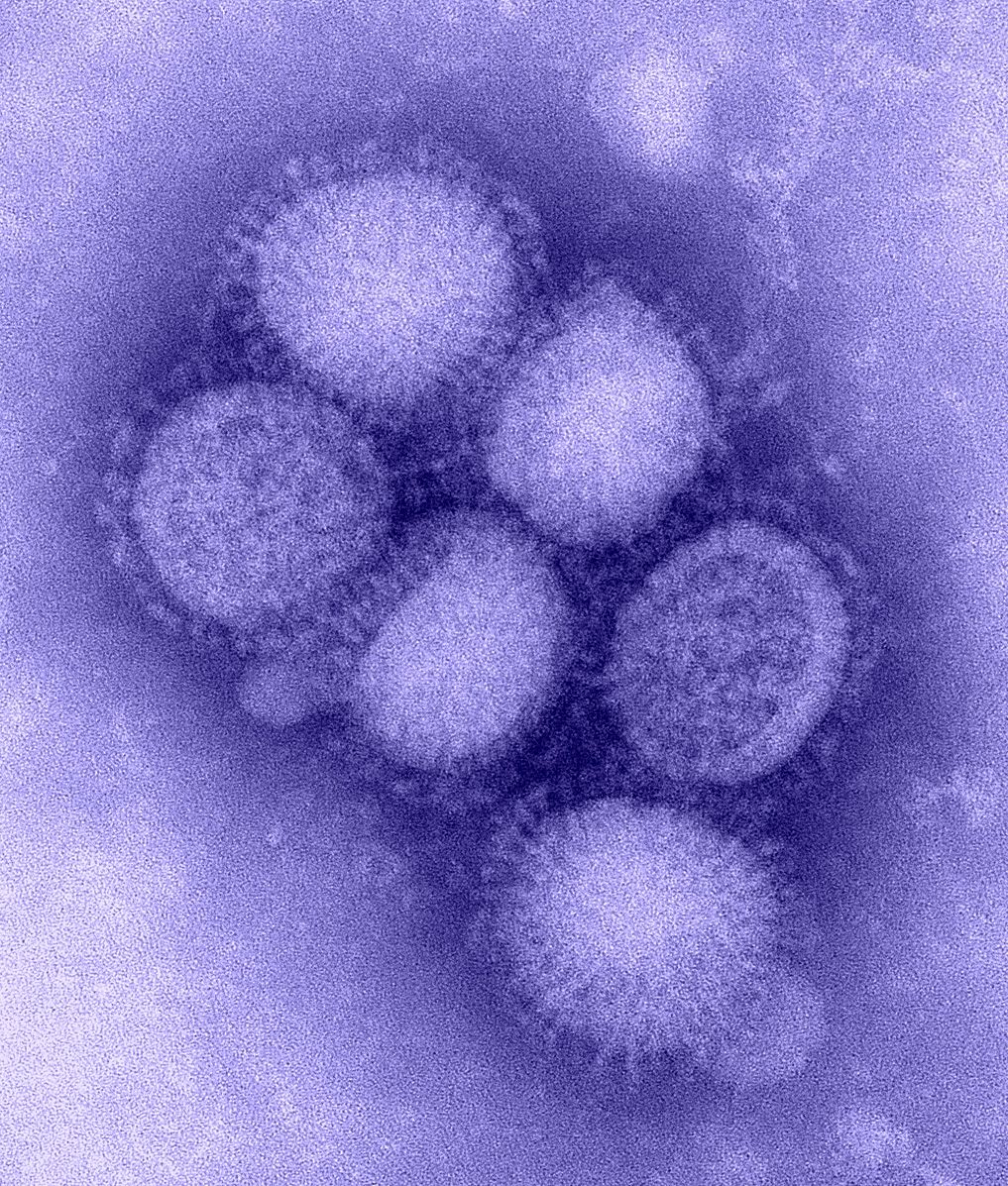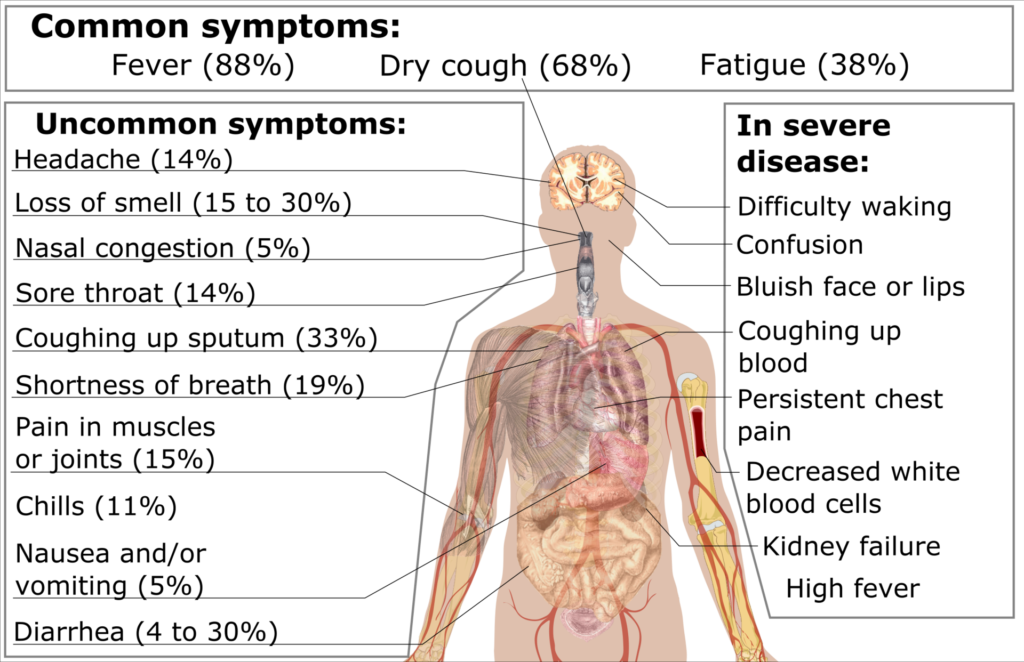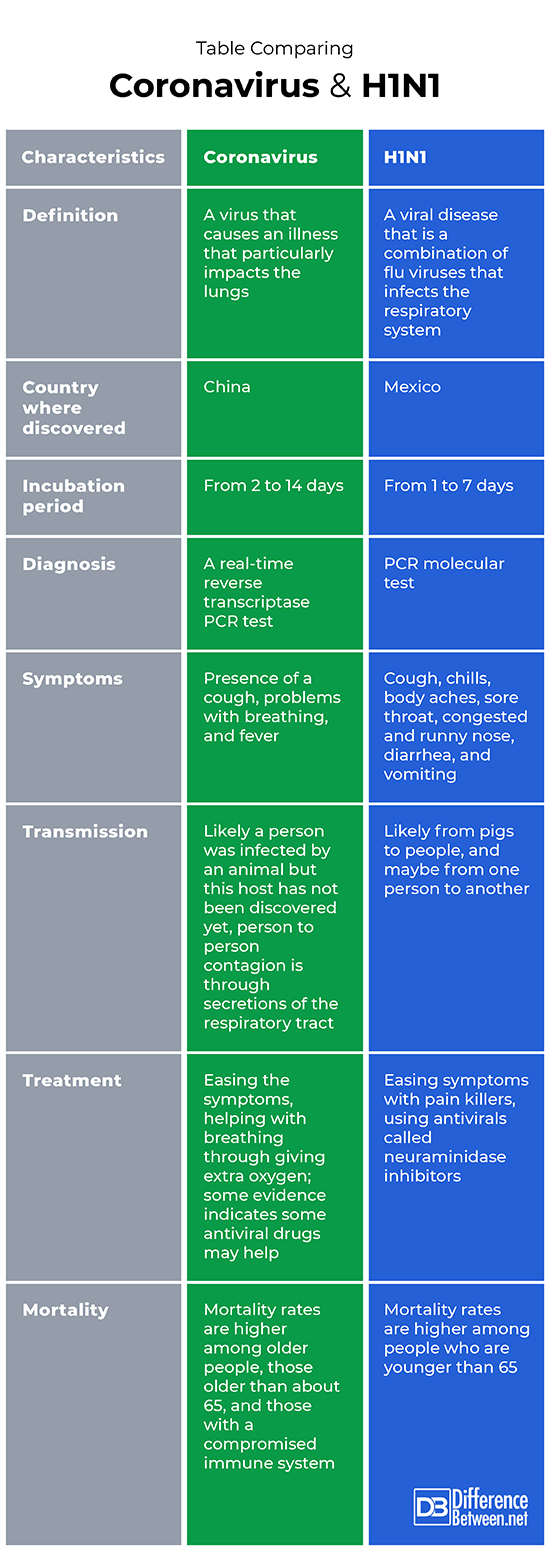Difference Between Coronavirus and H1N1
Coronavirus was first noticed in the Far East in 2019, where it was recorded in people who often developed severe pneumonia. H1N1 was first noticed in 2009 in Mexico where people began to become ill with flu usually associated with swine.

What is Coronavirus?
Definition:
Coronavirus is a causative agent for a condition in which the respiratory system is adversely affected, particularly the lungs.
Symptoms and complications:
Development of a fever and cough are common if you have coronavirus as are problems with breathing ability. A coronavirus infection is often found in the lungs where it causes problems for many individuals. Those persons most likely to die are individuals older than 65 years and who already have some chronic health problems.
Diagnosis:
The symptoms may suggest the illness, but the best way to tell if a person has coronavirus is by a molecular test called a real-time reverse transcriptase polymerase chain reaction test.
Transmission:
The recently discovered coronavirus probably came from an animal and infected a person. However, the actual animal species that is the host has not been discovered at this time. People can catch the virus when they come into contact with respiratory secretions that are expelled from a sick individual, and the virus is very contagious.
Risk factors:
A high-risk factor for infection is living where there is an outbreak and making contact with sick people. Healthcare workers are also at very high risk if they are treating infected people.
Treatment and prevention:
Symptoms can be treated but in many cases patients struggle to breathe and need to be given additional oxygen. In very severe situations a person may need to be placed on a mechanical ventilator. The best way to reduce your chance of infection is to avoid traveling to where there is an outbreak and to avoid contact with sick individuals.

What is H1N1?
Definition:
H1N1 is a type of influenza virus first noticed in 2009. It is a virus that can infect people, pigs, and birds and can occur as a pandemic; when found in people it is often described as a variant of the original H1N1.
Symptoms and complications:

Symptoms are similar to the usual flu, so include chills, cough, congested or runny nose, body aches and pains, headache and sore throat. A fever may be present, but not always. The H1N1 flu tends to more commonly include vomiting and diarrhea than does other strains of flu.
Diagnosis:
Symptoms can mimic other flu strains and thus the only way to positively identify that a person has H1N1 is to have a PCR test done in which the genetic material of the H1N1 virus is looked for.
Transmission:
Most commonly people are infected after coming into contact with pigs, although it is possible that some person to person transmission may occur at times.
Risk factors:
People who have contact with swine, such as those in agriculture and people in healthcare who come into contact with sick individuals are at the highest risk of catching H1N1.
Treatment and prevention:
People can be treated using medication that contains neuraminidase inhibitors; these antivirals have been shown to be useful. Sick individuals can take painkillers and NSAIDs to get symptom relief. The best way to prevent the flu is to get the yearly vaccine that does provide protection from H1N1.
Difference between Coronavirus and H1N1?
Definition
The coronavirus is a type of virus that often causes pneumonia and was first detected in the Far East. The H1N1 virus was discovered in Mexico and causes a type of flu commonly found in swine.
Country where discovered
Coronavirus was first found in Wuhan, China. H1N1 flu was first noticed in Mexico.
Incubation period
The incubation time of coronavirus is anywhere from 2 to 14 days. The incubation time of H1N1 is anywhere from 1 to 7 days.
Diagnosis
A real-time reverse transcriptase PCR test is used to detect and diagnose the presence of the new coronavirus. A PCR molecular test is used to detect and diagnose the H1N1 flu.
Symptoms
The coronavirus has symptoms such as difficulty in breathing, fever, and coughing. The H1N1 flu has several symptoms such as cough, chills, body aches and pains, runny or congested nose, sore throat, diarrhea, and vomiting.
Transmission
People can catch the coronavirus if they come into contact with expelled respiratory secretions of sick people. People can catch H1N1 from infected individual people and infected pigs.
Treatment
Coronavirus treatment works on easing the symptoms, and in many cases, extra oxygen may be needed. H1N1 symptoms can be eased with painkillers, and the flu can be treated by antivirals that are neuraminidase inhibitors.
Mortality
The most deaths from coronavirus are in people older than 65 and who have a chronic illness. The most deaths from H1N1 flu are in people younger than 65.
Table comparing Coronavirus and H1N1

Summary of Coronavirus Vs. H1N1
- Coronavirus and H1N1 are both viral conditions that infect the respiratory system.
- Both coronavirus and H1N1 are illnesses that probably were originally transmitted from a host animal into people and then from one person to another.
- Coronavirus was first discovered in Wuhan city in China while H1N1 was first discovered or noticed in Mexico.
- Difference Between Rumination and Regurgitation - June 13, 2024
- Difference Between Pyelectasis and Hydronephrosis - June 4, 2024
- Difference Between Cellulitis and Erysipelas - June 1, 2024
Search DifferenceBetween.net :
Leave a Response
References :
[0]Akpan, Nsikan. “new-coronavirus-spreading-between-humans-how-it-started”. National Geographic, 2020, https://www.nationalgeographic.com/science/2020/01/new-coronavirus-spreading-between-humans-how-it-started/
[1]Center for Disease Control and Prevention. “2019 Novel Coronavirus”. CDC, 2020, https://www.cdc.gov/coronavirus/2019-ncov/about/symptoms.html
[2]Tesini, Brenda L. “Pandemic 2009 H1N1 Influenza (Swine Flu)”. Merck Manual, 2018, https://www.msdmanuals.com/professional/infectious-diseases/respiratory-viruses/pandemic-2009-h1n1-influenza
[3]Image credit: https://commons.wikimedia.org/wiki/File:H1N1_influenza_virus.jpg
[4]Image credit: https://pixabay.com/de/illustrations/corona-coronavirus-virus-pandemie-4893276/
[5]https://commons.wikimedia.org/wiki/File:Symptoms_of_coronavirus_disease_2019_3.0.png
